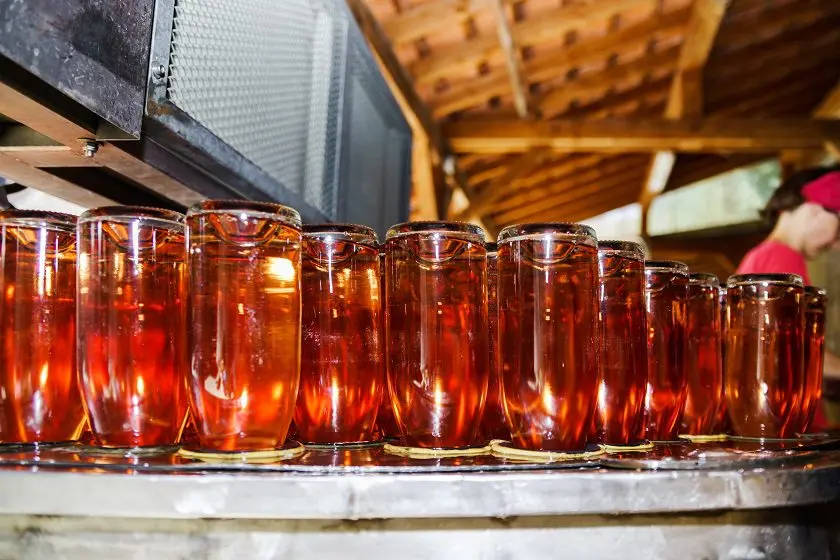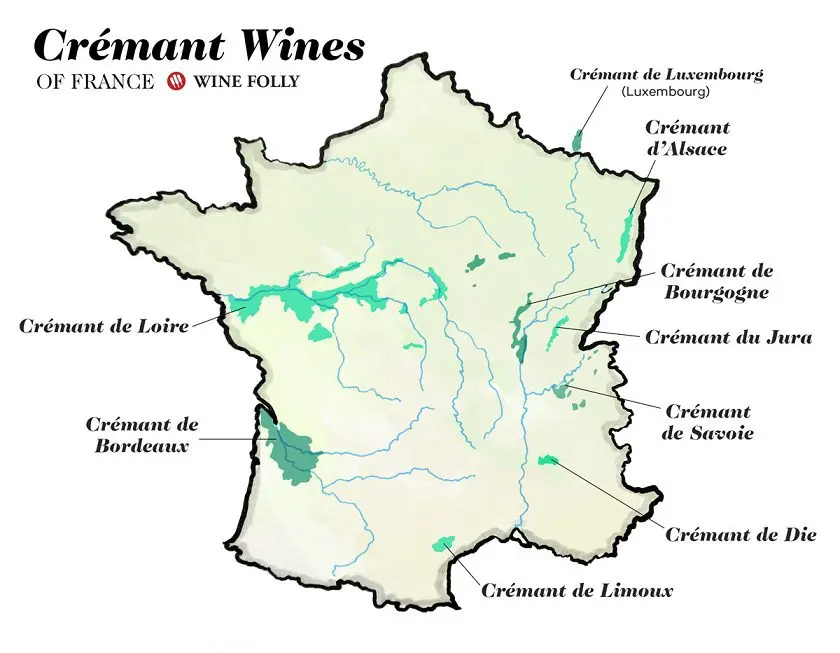Contents
Cremant is a slightly carbonated sparkling wine from France with a strength of 7-14% (usually 12-13%), it comes in white, pink, and sometimes even red. The name translates as “creamy” – thanks to light carbonation, the drink almost does not tingle the tongue and seems more creamy than carbonated. Cremant is made using the traditional method of champagne. Although the name “Cremant” itself is not legally protected by geographical origin, only 10 appellations (8 in France and one each in Luxembourg and Belgium) officially produce this wine. Theoretically, any European manufacturer can launch the production of a drink, the main thing is to follow the French style requirements impeccably.
History. Initially, “unsuccessful” champagne was called cremant – sparkling wine from the Champagne province, which turned out to be less carbonized than required – the pressure in the bottle is only 2-3 atmospheres (instead of the established 5-6 atmospheres). A little later, sparkling wine from the Loire Valley began to be called this way, without separating the drinks of the region into a separate wine-making appellation. In 1975, Cremant de Loire received the status of AOC, in the same year Creman de Bourgogne appeared, and a year later – Creman d’Alsace. In the 1990s, cremant was no longer produced in Champagne, and other appellations gradually appeared: Bordeaux, Limoux, etc.
Technology features
Cremant production rules are similar but less strict than those for champagne, not to mention that French winemaking is highly regulated, so the quality of the wine is always on top.
Kreman is made from hand-picked berries, and the yield of the site is strictly controlled and should not exceed the established norms. The varieties used in production are Chardonnay, Chenin Blanc, Cabernet Franc, Pinot Blanc, Pinot Gris, Sauvignon Blanc, Cabernet Sauvignon, Pinot Noir, Gamay, Malbec, Pinot d’Onis, Grollo, Aligote and others. An exact list of varieties, as well as their the ratio (proportions) depend on the specific appellation and manufacturer.
For carbonation, the traditional method of secondary fermentation (fermentation) in the bottle is used, the same as in the manufacture of champagne. Primary fermentation takes place in tanks, then the young wine is bottled, yeast and sugar are added. The future kreman is kept in the basement for at least 9 months. During this time, secondary fermentation takes place in the bottle and the drink is saturated with carbon dioxide. Toward the end of the exposure, the bottles are turned over so that the sediment accumulates near the neck. It remains for the winemaker to carry out disgorgement – to remove the cloudy sediment.

Differences between cremant and champagne
| Difference | Kreman | Champagne |
| Terrain | Produced in 10 regions in France, Belgium and Luxembourg, | Produced only in the Champagne region (France). |
| Grape varieties | It is made from a wide variety of grape varieties, depending on the appellation. | Only Chardonnay, Pinot Noir and Pinot Meunier are allowed. |
| Gassing | Weak – 2-3 atmospheres. | Strong – 5-6 atmospheres. |
| Exposure | From 9 months to 4 years (only elite varieties). | From 2 to 6 years old. |
| Taste | Delicate, creamy. | Sharper, notes depend on the sugar content. |
Cremant appellations

Cremant d ”Alsace (Эльзас). About 50% of all French cremant is produced here. Due to the dry and sunny climate of the region, the berries ripen well. Local wine can either be based on one variety (for example, Pinot Noir), or be a blend of different types of grapes.
Cremant de Bordeaux (Бордо). The only appellation where winemakers can produce cremant based on Sauvignon Blanc. The region accounts for no more than 2% of the market volume, the area is more famous for the still wines of Bordeaux.
Cremant de Bourgogne (Бургундия). The taste of sparkling wine varies from refreshing-dry to round, full-bodied. About 20% of creman is produced here. The region is adjacent to the province of Champagne, so the local cremant is most similar to its effervescent “big brother”, although it does not have such a complex bouquet.
In Burgundy, two elite types of cremant are produced:
- eminent (bottle aging from 24 months);
- grand eminent (cremant brut, aging from 36 months, minimum strength 10%).
Cremant de Die (Ди). Wine from the south-east of France from grapes growing at an altitude of 200-700 meters above sea level. This is one of the youngest French appellations, and the local sparkling wine is also drunk young and fresh. It is customary to cool the drink to 8-10 ° C and serve it before meals as an aperitif. Cremant de Di goes well with coffee, nuts, cakes, and light desserts.
Cremant du Jura (Жюра). It happens white, pink and even red (Pulsard, Trousseau, Pinot Noir varieties are used for the production of the latter type).
Cremant de Limoux (Лиму). White and rosé wine from the south of France. This region has historically produced sparkling wine – Blunkett in particular. Residents of Limou believe that they were the first in France to learn how to produce sparkling wines.
Cremant de Loire (Луара). It is famous for cremant with aromas of lemon, quince, pear, honey, chamomile. About 18% of the total French volume is produced in this region; wine can be made from as many as 9 grape varieties.
Savoy Cremation (Савуа). 60% consists of local grape varieties, the remaining 40% are Jacquere, sometimes with minor additions of Altesse, Chardonnay.
Burning of Luxembourg. Luxembourg Cremant, made according to French technology, goes well with fish dishes.
Cremation of Wallonia. Belgian variation of “creamy champagne”.

Sparkling wines from different appellations do not always have pronounced regional characteristics. Despite the place of origin, brands can be very similar, since cremant is made from many varieties of grapes.
What to drink with and how to drink cream
Cremant, like champagne, is served as an aperitif (before the main meal), eaten with cheeses, seafood, white meat, fruits, light meats, nuts. Before serving, the sparkling wine is cooled to 6-10 ° C, the bottle must be opened carefully, without the hussar “cork in the ceiling” and foamy streaks throughout the room.
Cremant is a democratic alcohol, so it is not necessary to put it in a bucket with ice, but it is recommended not to allow the drink to heat up above 10 ° C – at this temperature, old aged wine opens well, and cremant is only young.
Traditionally, cremant is drunk from flute glasses or special champagne glasses with a slightly pointed bottom or small indentations on the walls so that the “carbonated” wine forms even more bubbles. The glass is filled to a maximum of two-thirds.

Famous brands of cream
Bailly Lapierre, Maison Simmonet-Febvre, Jean-Charles Boisset, Jean Perrier и др.









